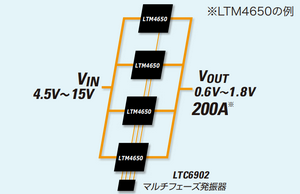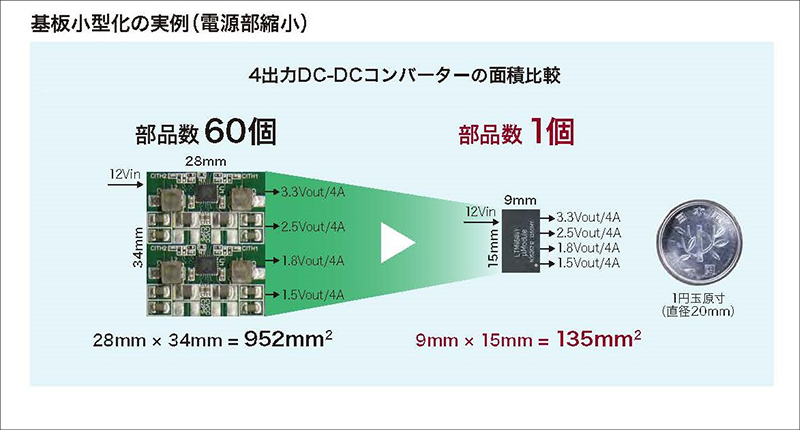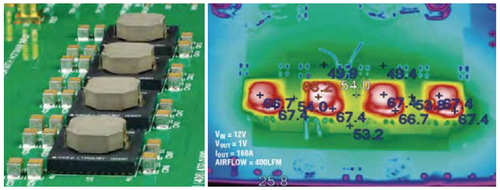FPGA のコア電圧は、定電圧・大電流化が進んでいます。その電源回路には、さらに省スペース、高い精度と高効率、長期供給性と設計の柔軟性が求められます。そのような難しい電源仕様に対して、インテルFPGAの評価キットに採用されている主な電源製品は、アナログ・デバイセズ社のμModule🄬 シリーズになります。μModule🄬 を採用しているメリットは、次のような内容になります。
高耐圧・大電流対応可能
アナログ・デバイセズ社のμModule🄬 は、入力電源が12V/24Vバス電圧に対応する製品も多く産業機器向けの設計に対応しやすい製品となっているため、FPGAとの親和性が高いです。
また、大規模なFPGAに対して大電流対応の電源回路が必要となる場合があるため、並列接続が可能な電源製品であることが採用するにあたって安心です。アナログ・デバイセズ社の電源製品は、優れた特性を持ったアンプを内蔵しているため安定した並列接続を可能としています。並列運転が可能なため、大電流対応が可能になりますし負荷応答性も改善します。 図1は、LTM4650を並列接続して最大200Aに対応する例になります。
また、Intel Agilex®シリーズから並列接続のマルチフェーズ動作により高速負荷応答が推奨しているので、並列接続可能であることは重要です。

小型ながら熱設計に考慮したパッケージ構造
マルチチャンネルで小型の電源回路
最近のFPGAは集積化が進み、ボード上にはFPGAの他に搭載されている主な部品は電源回路と言うボードは少なくありません。高性能なFPGA搭載のボードは、多層基板でありボードサイズがコストに直結します。
図2は、4チャンネル製品の例になります。FPGAの電源は複数必要になりますが、ディスクリートで組むと非常に電源の面積が大きくなります。これをワンパッケージ化した製品のひとつがLTM4643になります。これにより、小型化が実現できるとともに、基板のレイアウト設計も非常に簡単になります。

熱設計を考慮したパッケージ
電源回路を小型化する際に発生する問題は、熱になります。
アナログ・デバイセズ社のμModule🄬 は、熱抵抗を小さくなるようにパッケージを設計しています。図3は、LTM4636を4並列で動作させた際の温度上昇を確認した写真です。各モジュールは40Aの出力で合計160A供給する動作をしています。この時の温度上昇は、40℃と非常に小さい温度上昇で収まっています。また、各モジュールの温度が均一であることから、並列運転時の電流バランスが良く取れていることがわかります。
この様な特性を持つため、低電圧大電流が必要なFPGAのコア電圧にマッチした製品となっています。

PMBus対応
Intel Agilex®シリーズでは、Smart VID により半導体の製造ばらつきによるデバイスのマージンを個別に最適化して、パフォーマンスを維持しながら消費電力を削減することが可能になっています。
Smart VIDに対応するにはPMBusに対応した電源製品必要となり、アナログ・デバイセズ社のμModule🄬 またはパワーシステムマネージメント製品にて対応可能です。
まとめ
インテル社 FPGA の評価キットに採用されている特徴的な電源製品について、紹介させていただきました。
並列接続可能な電源モジュールにより、大電流かつ高速負荷応答対応が可能になっているため、FPGAを安定的に動作させるために非常に役立つソリューションとなっています。大電流対応に対しては熱設計も重要であり、熱抵抗や発熱が小さいパッケージ選定も重要です。FPGAは、SMART VID機能を用意することにより低消費電力化のサポートも行います。SMART VID対応の電源回路として、PMBus対応の製品選定も重要となります。
